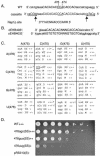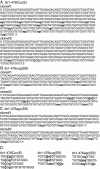Mutant telomere sequences lead to impaired chromosome separation and a unique checkpoint response
- PMID: 14742705
- PMCID: PMC379261
- DOI: 10.1091/mbc.e03-10-0740
Mutant telomere sequences lead to impaired chromosome separation and a unique checkpoint response
Abstract
Mutation of the template region in the RNA component of telomerase can cause incorporation of mutant DNA sequences at telomeres. We made all 63 mutant sequence combinations at template positions 474-476 of the yeast telomerase RNA, TLC1. Mutants contained faithfully incorporated template mutations, as well as misincorporated sequences in telomeres, a phenotype not previously reported for Saccharomyces cerevisiae telomerase template mutants. Although growth rates and telomere profiles varied widely among the tlc1 mutants, chromosome separation and segregation were always aberrant. The mutants showed defects in sister chromatid separation at centromeres as well as telomeres, suggesting activation of a cell cycle checkpoint. Deletion of the DNA damage response genes DDC1, MEC3, or DDC2/SML1 failed to restore chromosome separation in the tlc1 template mutants. These results suggest that mutant telomere sequences elicit a checkpoint that is genetically distinct from those activated by deletion of telomerase or DNA damage.
Figures






Similar articles
-
Interactions of TLC1 (which encodes the RNA subunit of telomerase), TEL1, and MEC1 in regulating telomere length in the yeast Saccharomyces cerevisiae.Mol Cell Biol. 1999 Sep;19(9):6065-75. doi: 10.1128/MCB.19.9.6065. Mol Cell Biol. 1999. PMID: 10454554 Free PMC article.
-
Altering telomere structure allows telomerase to act in yeast lacking ATM kinases.Curr Biol. 2001 Aug 21;11(16):1240-50. doi: 10.1016/s0960-9822(01)00391-8. Curr Biol. 2001. PMID: 11525738
-
MEC3, MEC1, and DDC2 are essential components of a telomere checkpoint pathway required for cell cycle arrest during senescence in Saccharomyces cerevisiae.Mol Biol Cell. 2002 Aug;13(8):2626-38. doi: 10.1091/mbc.02-02-0012. Mol Biol Cell. 2002. PMID: 12181334 Free PMC article.
-
Telomeres and the DNA damage response: why the fox is guarding the henhouse.DNA Repair (Amst). 2004 Aug-Sep;3(8-9):979-88. doi: 10.1016/j.dnarep.2004.05.009. DNA Repair (Amst). 2004. PMID: 15279784 Review.
-
Beginning to understand the end of the chromosome.Cell. 2004 Jan 23;116(2):273-9. doi: 10.1016/s0092-8674(04)00038-8. Cell. 2004. PMID: 14744437 Review.
Cited by
-
Identification of the determinants for the specific recognition of single-strand telomeric DNA by Cdc13.Biochemistry. 2006 Jan 24;45(3):871-9. doi: 10.1021/bi0512703. Biochemistry. 2006. PMID: 16411763 Free PMC article.
-
Regulation of telomere structure and functions by subunits of the INO80 chromatin remodeling complex.Mol Cell Biol. 2007 Aug;27(16):5639-49. doi: 10.1128/MCB.00418-07. Epub 2007 Jun 11. Mol Cell Biol. 2007. PMID: 17562861 Free PMC article.
-
Rif2 protects Rap1-depleted telomeres from MRX-mediated degradation in Saccharomyces cerevisiae.Elife. 2022 Jan 19;11:e74090. doi: 10.7554/eLife.74090. Elife. 2022. PMID: 35044907 Free PMC article.
-
Telomerase: an RNP enzyme synthesizes DNA.Cold Spring Harb Perspect Biol. 2011 May 1;3(5):a003558. doi: 10.1101/cshperspect.a003558. Cold Spring Harb Perspect Biol. 2011. PMID: 20660025 Free PMC article. Review.
-
Pot1b -/- tumors activate G-quadruplex-induced DNA damage to promote telomere hyper-elongation.Nucleic Acids Res. 2023 Sep 22;51(17):9227-9247. doi: 10.1093/nar/gkad648. Nucleic Acids Res. 2023. PMID: 37560909 Free PMC article.
References
-
- Blackburn, E.H. (2000a). The end of the (DNA) line. Nat. Struct. Biol. 7, 847-850. - PubMed
-
- Blackburn, E.H. (2000b). Telomere states and cell fates. Nature 408, 53-56. - PubMed
-
- Blackburn, E.H. (2000c). Telomeres and telomerase. Keio J. Med. 49, 59-65. - PubMed
-
- Blackburn, E.H. (2001). Switching and signaling at the telomere. Cell 106, 661-673. - PubMed
MeSH terms
Substances
LinkOut - more resources
Full Text Sources
Molecular Biology Databases

